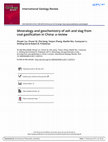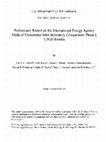Papers by Robert Finkelman
This report is preliminary and has not been reviewed for conformity with U.S. Geological Survey e... more This report is preliminary and has not been reviewed for conformity with U.S. Geological Survey editorial standards. Any use of trade, product, or firm names is for descriptive purposes only and does not imply endorsement of the U.S. Government.

Routledge eBooks, Apr 28, 2020
China is the largest coal gasification market in the world. The gasifiers have been commercialize... more China is the largest coal gasification market in the world. The gasifiers have been commercialized for producing syngas for coal-to-liquids, coal-to-olefin, and coal-to-substitute natural gas. During coal gasification at high temperature and pressure, the differences in reactivity of organic matter in coal are almost negligible; however, the transformation behaviour of minerals is important to the stability of the process. Detailed knowledge of the mineralogical properties of ash and slag is essential for optimizing the operational parameters. It is also significant for determining the influence of the solid wastes on the environment: for example, trace elements carried in bottom slag, fly ash, condensate water, and gaseous products migrate to natural water and soil and into the atmosphere. With this in mind, the mineralogy of ash and slag from typical coal gasification processes in China are reviewed, including the transformation of minerals typically found in coal, and the effects of operating conditions on mineral transformation and melting/slagging behaviour of minerals during gasification process. In addition, trace element migration behaviour in commercialized gasifiers is discussed.
Routledge eBooks, Apr 28, 2020

Open-File Report, 1999
determined on 550 °C ash by ICP-MS using techniques similar to those of Meier (1997). Mercury was... more determined on 550 °C ash by ICP-MS using techniques similar to those of Meier (1997). Mercury was determined by CVAA using techniques similar to those of O'Leary (1997). Selenium was determined by HGAA (O'Leary, 1997). For the eighteen elements which were determined by more than one technique the results with the lowest uncertainty were used. The technique used for each element are given in Appendices 1A-1C. The combination of techniques used by the USGS provides data on a large number of elements with great reliability (Palmer and Klizas, 1997). Selective Leaching The sequential selective leaching procedure used in this study is similar to that described by Palmer et al. (1993), modified from that of Finkelman et al. (1990). Duplicate 5 g coal samples were sequentially leached with 35 ml each of IN ammonium acetate (CHaCOONH^), 3N hydrochloric acid (HC1), concentrated hydrofluoric acid (HF; 48%) and 2N (1:7) nitric acid (HNOs) in 50 ml polypropylene tubes. Each tube was shaken for 18 hrs using a motorized shaker. Because gas can form during the leaching procedure, it is necessary to enclose each tube in double polyethylene bags, which allow gas to escape, but prevent the release of liquid. After leaching, the coal slurries were centrifuged and the resulting solutions were saved for ICP-AES and ICP-MS analysis. The coal was washed at least five times with distilled water, using an ultrasonic cleaner to remove the solvent. After removing the solvent and drying the residual solid, about 0.5 g of this material was removed from each tube for INAA, and CVAA analysis for Hg. Chemical data for the leachates and residues were processed to derive the percentages of each element leached by each of the four leaching agents. The calculated percentages were then used as an indirect estimate of the modes of occurrence of specific trace elements in the coals. These results were determined for 44 elements. By comparing data for the residual fractions with data for the solutions, we estimate a relative error of up to ±20 percent and an absolute error of +10 percent, for the leached percentages reported. Scanning Electron Microscopy Coal-epoxy pellets were prepared for SEM and electron microprobe analysis following the ASTM D2797-85 technique for anthracite and bituminous coal (ASTM, 1993). The casting procedure impregnates, under pressure, about 7-8 grams of crushed coal sample with epoxy. The coal-epoxy mixture is poured into a mold, cured overnight at 60 °C. and ground on a 15 jim diamond platen and 600-grit SiC paper until flat and smooth. Rough polishing is done with 1 jam alumina and final polishing is completed with 0.06 jam colloidal silica. Ultrasonic cleaning between and after the various steps insures a final product free of extraneous abrasive material.
Abstracts with programs, 2020
Applied Geochemistry, May 1, 2023
Social Science Research Network, 2022
Deposits associated with intracontinental rifts, anorogenic settings, and Proterozoic to Archean ... more Deposits associated with intracontinental rifts, anorogenic settings, and Proterozoic to Archean greenstone belts Residual or placer deposits: *Quartz-pebble conglomerate uranium-gold (29a) Magmatic deposits: *Bushveld chromium (2a) *Dunitic nickel-copper (6b) *Komatiitic nickel-copper (6a)

Uploads
Papers by Robert Finkelman